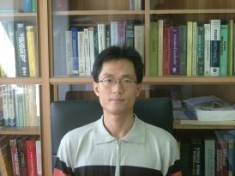Direct Simulation Monte Carlo Method for Chemical Reactions and Non-equilibrium Processes in Supersonic Combustion and Hypersonic Applications

Peter Kuo-Long Pan, PhD
National Taiwan University
Abstract: The Direct Simulation Monte Carlo (DSMC) method has been largely adopted to analyze problems regarding hypersonic, non-equilibrium, and microscopic flows. In this study, we investigate thermal-chemical effects on combustion at the microscopic scale by using this particle collision-based method. It is realized that the existing Larsen-Borgnakke (L-B) model dealing with transfers of various internal energies cannot provide valid solutions for the reactions, and consequently the system fails to reach thermal equilibrium. To overcome this problem, we have proposed a modified quantum-kinetic (Q-K) model and corresponding redistribution algorithm of energy to satisfy the required detailed balance that is key to thermal equilibrium. To verify the accuracy, spontaneous combustion of premixed H2/O2 is simulated, which includes polyatomic reactions and non-equilibrium processes. Compared with the L-B redistribution method, substantial improvement and excellent solutions to the issues are demonstrated by using the new approach. It is further applied to study the Richtmyer-Meshkov instability (RMI), which is caused by the interplay of shock waves with fuel interfaces when passing through and can play a dominant role in the mixing processes necessitated by a scramjet combustor. Specifically, it was found that the nonequilibrium effect slowed down the heat release of chemical reactions and strengthened the viscous and diffusive effects for the mixture and shock conditions tested, which inhibited the growth of the RM instability. The heat release via combustion, however, could substantially increase the RMI growth due to induced baroclinic torque. Consequently, the intricate coupling of these effects nonlinearly dominated the development of RMI at the microscale. The study provides a paradigm for further research in pursuit of accurate evaluation of microscopic processes and the resulted performance in supersonic combustion which plays a key role in the development of hypersonic vehicles.
Biography: Dr. Kuo-Long Pan is a professor in National Taiwan University. He graduated in 2004 from Princeton University, Department of Mechanical and Aerospace Engineering, where he is currently visiting. His research interests are mainly in fluid physics, combustion and energy, computational fluid dynamics, and propulsion. Recent topics regard droplet collisions, multiphase flows, nonlinear flame dynamics, microgravity droplet combustion, biofuels, micro/nano fluidics, surfactant, flying machines and mechanics, high-speed flow and electromagnetic propulsion, plasma simulation and plasma-enhanced chemical vapor deposition, geothermal energy and turbine design, etc. He is a member of American Physical Society and Associate Fellow of American Institute of Aeronautics and Astronautics.